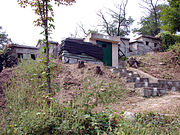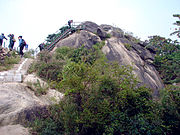Inwangsan




Inwangsan (Korean: 인왕산) is a mountain in central Seoul, South Korea. It is in parts of Jongno District and Seodaemun District and has a height of 338 m (1,109 ft).[1] The name literally means "compassionate/benevolent king" in Korean. The mountain covers an area of 1,086,696.50 m2 and has many huge granite peaks which distinguish it from other mountains in Seoul. Each rock is named after its characteristic form, such as Gichabawi (기차바위; lit. train rock), Chimabawi (치마바위; lit. skirt rock), Iseulbawi (이슬바위; lit. dew rock), Mojabawi (모자바위; lit. hat rock), and Jiryeongibawi (지렁이바위; lit. worm rock).[citation needed]
Inwangsan is famous for its view, so many painters depicted the mountain in their works such as Jeong Seon's Inwang jesaekdo. The Fortress Wall of Seoul surrounds the mountain in which the temple Inwangsa and shrine Guksadang are located as well.[2] Access to certain parts of the mountain, including the peak are limited during certain days and times due to the location of a military installation spanning different parts of the mountain.[3]
History
During the reign of King Sukjong of Goryeo, there was a palace in Namgyeong (Seoul), the capital of the south, and it was recorded as Myeongak. Later in the Joseon period, the mountain was called "Baegaksan", as there was a shrine dedicated to the mountain god. Since then, it has been called Bugaksan because it is located in the north among the mountains surrounding Seoul. The mountain facing the south was called Namsan. The height of the mountain is 342 m (1,122 ft), and it is gently flat to the south, and has a triangular raised shape that looks better than the surrounding mountains. After the collapse of Goryeo and the establishment of Joseon Dynasty, King Taejo Lee Seong-gye established the palace as a royal palace, and it was honored as a royal palace. When the Joseon Dynasty was founded, a shrine to honor the mountain god was created at the Sanjeong Department. South Korea at the Gyeongbok Palace, below the mountain in 1394 (Taejo of four years), fortification and gyeongmudae, the president's office (景武臺) in here, too. (靑瓦臺) Cheong Wa Dae, currently president of the office is located below the mountain.[4]
In 1939, the Japanese Government-General of Chōsen carved a message into the side of Chimabawi in Chinese characters: 東亞靑年團結.[5][6] The message is dedicated to a Japanese pan-Asianist youth society.[5] After the 1945 liberation of Korea, an attempt was made to scratch out the message, but part of it still remains in the rock.[6]
Inwangsa
Inwangsa is a temple that can be found at the southern foot of Inwangsan mountain. The temple was established in the early Joseon dynasty to guard Gyeongbokgung palace to the east.[7] There are 11 shrines from five Buddhist orders leading up to Seonbawi, an unusuaul rock formation that has been used for many shamanist rites and rituals. One of the shrines in Inwangsa is Guksadang, a famous shamanist shrine that is actively used for rituals to this day.
Gallery
-
 Fortress wall of Seoul on the mountain
Fortress wall of Seoul on the mountain -
 Steps and fort wall
Steps and fort wall -
 Fort wall overlooking Seoul
Fort wall overlooking Seoul -
 Near the peak
Near the peak -
 On the top
On the top -
 Fort wall reconstruction
Fort wall reconstruction -
 Remaining vigilant
Remaining vigilant -
 Trail of Inwangsan
Trail of Inwangsan
See also
References
- ^ 김, 주환, "인왕산 (仁王山)", Encyclopedia of Korean Culture (in Korean), Academy of Korean Studies, retrieved 2024-07-26
- ^ 인왕산 공원 (in Korean). The official site of the Seoul Metropolitan Government. Retrieved 2008-05-05. [dead link]
- ^ Guides, Rough (2018-11-01). The Rough Guide to Seoul (Travel Guide eBook). Apa Publications (UK) Limited. ISBN 978-1-78919-518-7.
- ^ 북악산 (in Korean). Retrieved 2018-05-26.
- ^ a b 이, 성우 (2021-10-17). "[이성우의 청와대와 주변의 역사·문화 이야기(23)] 일제가 '동아청년단결' 구호 새긴 인왕산(仁旺山) 바위". 중앙시사매거진. Retrieved 2024-07-28.
- ^ a b 신, 병주 (2021-10-06). "7일의 왕비 단경왕후, 인왕산 바위에 그리움을 새기다". mediahub.seoul.go.kr (in Korean). Retrieved 2024-07-28.
- ^ 윤, 기엽, "인왕사 (仁旺寺)", Encyclopedia of Korean Culture (in Korean), Academy of Korean Studies, retrieved 2024-07-26
External links

- Inwangsan : Official Seoul City Tourism(English)
- (in Korean) Introduction of Inwangsan
- (in Korean) Travel to Inwangsan



















